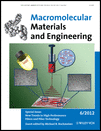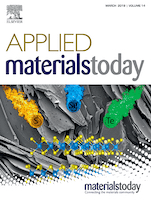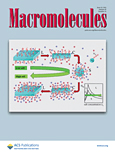
MACROMOLECULAR MATERIALS AND ENGINEERING
Scope & Guideline
Exploring New Horizons in Macromolecular Materials
Introduction
Aims and Scopes
- Polymer Science and Engineering:
The journal covers a wide range of topics in polymer science, including synthesis, characterization, and application of macromolecular materials. - Biomedical Applications:
A significant focus is placed on the development of polymers for biomedical applications, such as drug delivery systems, tissue engineering scaffolds, and wound care materials. - Sustainable Materials:
There is an emphasis on sustainable and eco-friendly materials, including biopolymers and recyclable composites that address environmental concerns. - Advanced Manufacturing Techniques:
The journal discusses innovative manufacturing techniques such as 3D printing, electrospinning, and melt electrowriting, highlighting their applications in creating advanced polymer structures. - Functional Materials:
Research on functional polymers, including conductive, piezoelectric, and shape-memory materials, is a core area, exploring their applications in sensors, actuators, and energy storage.
Trending and Emerging
- Smart and Responsive Materials:
There is an increasing focus on smart materials that respond to environmental stimuli, such as temperature, pH, or light, which are being developed for applications in soft robotics and wearable technology. - Biodegradable and Bio-based Polymers:
Research into biodegradable and bio-based polymers is on the rise, driven by the demand for sustainable materials that can mitigate plastic pollution and reduce reliance on fossil fuels. - Nanocomposites and Hybrid Materials:
The integration of nanomaterials into polymer matrices is a growing area of interest, enhancing properties such as strength, conductivity, and thermal stability for advanced applications. - Advanced Characterization Techniques:
Emerging themes include the use of advanced characterization methods to better understand polymer behavior and properties at the nanoscale, contributing to more precise material design. - Interdisciplinary Approaches:
There is a trend towards interdisciplinary research that combines polymer science with fields such as nanotechnology, biotechnology, and material science, leading to innovative solutions for complex challenges.
Declining or Waning
- Conventional Polymer Processing Techniques:
There is a noticeable decline in research focusing on traditional polymer processing methods, such as simple extrusion or molding, as attention shifts toward more advanced and sustainable techniques. - Basic Polymer Chemistry:
Papers purely centered around foundational polymer chemistry, without direct application or innovation, are becoming less frequent as the journal prioritizes interdisciplinary and application-driven research. - Single-Function Polymers:
Research on polymers designed for single functionalities (e.g., solely for mechanical strength) is waning, with a growing preference for multifunctional materials that offer combined properties.
Similar Journals

Applied Materials Today
Transforming Research into Real-World Solutions.Applied Materials Today is a leading peer-reviewed journal published by ELSEVIER, dedicated to the field of materials science. With an impressive impact factor and ranked in the Q1 category for materials science (miscellaneous) in 2023, this journal stands out as a crucial platform for sharing groundbreaking research and innovative applications of materials. Based in the Netherlands, the journal has rapidly gained recognition, achieving a remarkable Scopus ranking of 41 out of 463, placing it in the 91st percentile among general materials science publications. Covering a broad range of topics, from the synthesis and characterization of materials to their practical applications, Applied Materials Today seeks to inspire and inform researchers, professionals, and students alike. Its commitment to disseminating high-quality, open-access content ensures that cutting-edge discoveries in materials science can be shared with a global audience, fostering collaboration and advancements in the field.

ADVANCED MATERIALS
Connecting Ideas, Driving Innovation in Materials ScienceAdvanced Materials, published by Wiley-VCH Verlag GmbH, is a premier academic journal that serves as a crucial platform for cutting-edge research in the field of materials science and engineering. With an impressive impact factor and ranking among the top tiers in various categories, including Materials Science, Mechanical Engineering, and Nanoscience, this journal is recognized for its high-quality contributions and relevance to contemporary research challenges. Spanning from 1989 to 2024, Advanced Materials not only features groundbreaking studies but also provides insights into innovative applications and advancements in material design and engineering. Researchers, professionals, and students alike will benefit from the rigorous peer-review process and diverse range of topics covered, making it an indispensable resource for those aiming to stay at the forefront of materials science innovation.

Polymer-Plastics Technology and Materials
Pioneering Research in Materials ChemistryPolymer-Plastics Technology and Materials is a premier academic journal published by Taylor & Francis Inc., dedicated to the dynamic fields of chemical engineering, materials chemistry, and polymers and plastics. With an impact factor that reinforces its reputation, this journal is strategically indexed in Scopus, ranked notably within its categories (Q2), showcasing its influence and relevance in the academic community. Since its inception in 2019, the journal has served as an essential platform for researchers, professionals, and students to disseminate innovative studies and advancements in polymer science and materials technology. As an Open Access publication, it ensures that cutting-edge research is accessible to a global audience, fostering collaboration and knowledge sharing in the material sciences. Located in the United Kingdom, Polymer-Plastics Technology and Materials continues to enhance the dialogue within the industry, addressing critical challenges and exploring emerging trends that shape the future of polymer and plastics technologies.

MACROMOLECULAR BIOSCIENCE
Driving Discovery in Polymers and BiotechnologyMACROMOLECULAR BIOSCIENCE, published by WILEY-V C H VERLAG GMBH, is a leading journal in the fields of bioengineering, biomaterials, biotechnology, materials chemistry, and polymers and plastics. With a convergence of scientific inquiry since its inception in 2001, the journal has established itself as a vital resource for researchers and professionals exploring the interface of molecular sciences and biosystems. It boasts impressive Scopus rankings, including Q1 status in multiple categories, reflecting its significant contribution to advancing knowledge and innovation in the polymer and biomaterials domains. While the journal does not currently offer open access options, its rigorous peer-review process ensures the publication of high-quality research that fuels academic discourse. Positioned in Weinheim, Germany, MACROMOLECULAR BIOSCIENCE aims to bridge theoretical understanding with practical applications, making it an essential reference for students, academics, and industry practitioners dedicated to the evolving landscape of macromolecular bioscience.

ACS Macro Letters
Pioneering Insights in Inorganic and Materials ChemistryACS Macro Letters, published by the American Chemical Society, is a leading journal in the fields of Inorganic Chemistry, Materials Chemistry, Organic Chemistry, and Polymers and Plastics. Established in 2012, this journal has swiftly ascended to the forefront of chemical research with an impressive reputation, as evidenced by its 2023 Scopus rankings placing it in the first quartile across multiple categories. The journal's objective is to disseminate timely and concise articles that advance the study of macromolecules and their applications, making it an essential resource for researchers, professionals, and students alike. With a focus on fostering innovation and facilitating collaboration within the chemical community, ACS Macro Letters presents a robust platform for scientists to share their groundbreaking findings. Being based in the United States, it serves as a central hub for global discourse in the chemical sciences, although it does not currently offer Open Access options. The journal's commitment to high-quality content is further underscored by its prestigious impact factor and acceptance into elite academic quartiles, signifying its influence and importance in shaping future research.

Materials Today
Unveiling the Science Behind Material MarvelsMaterials Today is a premier academic journal published by Elsevier Science Ltd, specializing in the dynamic fields of materials science, mechanical engineering, and condensed matter physics. Established in 1999, the journal has garnered an enviable reputation, consistently ranking in the Q1 category across multiple disciplines including mechanics of materials and general materials science, reflecting its influence and high-quality research output. With an impressive Scopus ranking—4th in both mechanical engineering and mechanics of materials, and 6th in condensed matter physics—Materials Today serves as an essential resource for researchers, professionals, and students seeking to stay at the forefront of developments in material innovations and applications. The journal is known for its commitment to publishing significant research findings and reviews, making it a vital platform for disseminating knowledge and fostering collaboration in the rapidly evolving materials field. Although it does not offer open access, its robust impact factor underscores the importance of the content published, ensuring wide visibility and citation among the academic community. Explore the rich tapestry of materials research with Materials Today, where groundbreaking insights pave the way for future technological advancements.

MACROMOLECULES
Unveiling the Secrets of MacromoleculesMACROMOLECULES, published by the American Chemical Society, is a premier journal in the fields of inorganic chemistry, materials chemistry, organic chemistry, and polymers and plastics. Since its inception in 1968, this influential journal has established itself as a vital resource for researchers, professionals, and students, showcasing cutting-edge research and advancements in the study of macromolecules and high-performance polymers. With a distinguished impact factor and consistently ranking in the top quartiles (Q1) across its relevant categories, MACROMOLECULES is recognized for its high-quality publications that contribute significantly to the scientific community. The journal is accessible in both print and electronic formats, facilitating rapid dissemination of knowledge. By providing a platform for innovative studies and groundbreaking discoveries, MACROMOLECULES continues to play a crucial role in shaping the future of materials science and polymer research.

Accounts of Materials Research
Unveiling groundbreaking discoveries in materials science.Accounts of Materials Research is a premier journal published by the American Chemical Society, focusing on the multidimensional field of materials science. With a robust impact factor and a commitment to open-access research, it serves as a vital platform for leading-edge discoveries from 2020 to 2024. The journal has rapidly ascended to the top quartile in multiple categories, including Chemical Engineering, Materials Chemistry, and Polymers and Plastics, demonstrating its significant influence within the academic community. Recognized by Scopus as a key resource—with remarkable rankings that place it in the 95th percentile of its field—Accounts of Materials Research is devoted to publishing high-quality, innovative research that addresses critical challenges in materials development and implementation. This journal is essential for researchers, professionals, and students seeking to stay informed about the latest advancements and collaborative opportunities within the interdisciplinary landscape of materials science.

MATERIALS LETTERS
Delivering concise discoveries in materials science.MATERIALS LETTERS, published by ELSEVIER, is a premier journal dedicated to the rapid dissemination of significant advances in the field of materials science and engineering. With an impressive impact factor and a solid reputation reflected in its ranking within the Q2 quartile of various categories such as Condensed Matter Physics, Materials Science, Mechanical Engineering, and Mechanics of Materials, it provides a platform for researchers, professionals, and students to share focused and innovative research findings from 1982 to the present. Despite being a subscription-based journal, its accessibility through institutional and personal subscriptions ensures a wide reach in the academic community. By presenting concise reports, the journal aims to bridge the gap between fundamental research and practical applications, highlighting the critical role of materials in technological advancement. The journal's ISSN is 0167-577X and the E-ISSN is 1873-4979. For researchers looking to publish their work or follow the latest trends in materials science, MATERIALS LETTERS stands as an essential resource, contributing significantly to the discourse in this dynamic field.

Emergent Materials
Transforming Challenges into Solutions in Material Science.Emergent Materials is a leading journal in the fields of biomaterials, ceramics, composites, and environmental science, published by SpringerNature. With an ISSN of 2522-5731 and an E-ISSN of 2522-574X, this journal serves as a crucial platform for researchers and professionals seeking to publish their findings on innovative materials that drive advancements across various applications. Renowned for its impactful contributions, Emergent Materials currently holds a Q2 ranking in Biomaterials and Waste Management, and a prestigious Q1 ranking in Ceramics and Composites for 2023, showcasing its excellence in these dynamic fields. Positioned within Switzerland, the journal supports a wide array of open access research initiatives, allowing for greater dissemination and accessibility of critical scientific knowledge. Spanning over the years 2018 to 2024, the journal aims to publish groundbreaking studies that address global challenges in sustainability, energy, and material disposal. With an impressive Scopus ranking highlighting its impactful presence, generate compelling insights and stay at the forefront of material sciences with Emergent Materials.